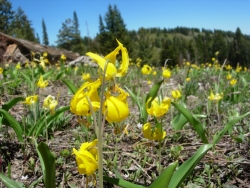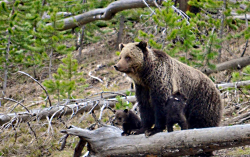
Courtesy Andrea Liberatore, Photographer

Courtesy USGS
Frank T. van Manen, Photographer
After digging up glacier lilies, bears often leave the bulbs for a few days to wilt in the sun. This “cooks” them a bit making them sweeter and easier to digest. First Nations lore shows that early peoples learned to dry and cook glacier lily bulbs by copying the grizzly. Black bears relish the bulbs as well while Elk and deer munch the foliage.
The Shoshone ate the corms fresh or with soup, and the dried bulbs were a popular trade item between tribes. The leaves are edible as well and the green seedpods taste like green beans when cooked. Medical applications include reducing fever, swelling, infection, and they were used as a contraceptive. The glacier lily was collected during the Lewis and Clark Expedition. Meriwether Lewis mentioned this species numerous times in his journal. This may be because he thought it could be used as a “botanical calendar” to help track the onset of spring.
Glacier lilies are very sensitive to disturbance and harvesting the corm will effectively kill the plant. Though native tribes practiced active management of them, their populations have been greatly reduced. It is better to leave collection to wildlife.
“The snow is melting. The grizzly bears that have been sleeping beneath the snow, suspended like seeds, will prowl the warm fields just beneath the snow, grazing on the delicious emerging lilies. Sometimes the yellow pollen gets caught on the fur and snouts of the great golden bears as they grub and push through the lily fields, pollinating other lilies in this manner. In this crude fashion, they are famers of a kind, nurturing and expanding one of the crops that first meets them each year. The lilies follow the snow, and the snow pulls back to reveal the bears, and the bears follow the Lilies. The script of life begins moving with enthusiasm once again.” Rick Bass, author, naturalist, activist.
Jack Greene for Bridgerland Audubon Society and you guessed it- I’m wild about Utah, and its long lost grizzlies
Credits:
Images: Courtesy & © Andrea Liberatore
Bear image: Courtesy USGS, Frank T van Manen, Photographer
Featured Audio: Courtesy & Copyright © Kevin Colver, https://wildstore.wildsanctuary.com/collections/special-collections/kevin-colver
Text: Jack Greene, https://bridgerlandaudubon.org/
Additional Reading:
Glacier Lily — Erythronium grandiflorum. Montana Field Guide. Montana Natural Heritage Program. Retrieved on April 18, 2021, from https://FieldGuide.mt.gov/speciesDetail.aspx?elcode=PMLIL0U050
Alberty, Erin, Wasatch wildflower update: Early blooms emerging in low places, The Salt Lake Tribune, March 22, 2017, https://archive.sltrib.com/article.php?id=5090577&itype=CMSID
Rey-Vizgirdas, Edna, Forest Botanist, Boise National Forest, Yellow Avalanche-lily (Erythronium grandiflorum), Forest Management, Rangelands Management, & Vegetation Ecology Programs, USDA Forest Service, https://www.fs.fed.us/wildflowers/plant-of-the-week/erythronium_grandiflorum.shtml
McConnell, Tatum, Vital Ground Communications Intern, How Grizzly Bear Digging Shapes Mountain Meadows, The Vital Ground Foundation, https://www.vitalground.org/grizzly-ecology-bears-and-dirt/
